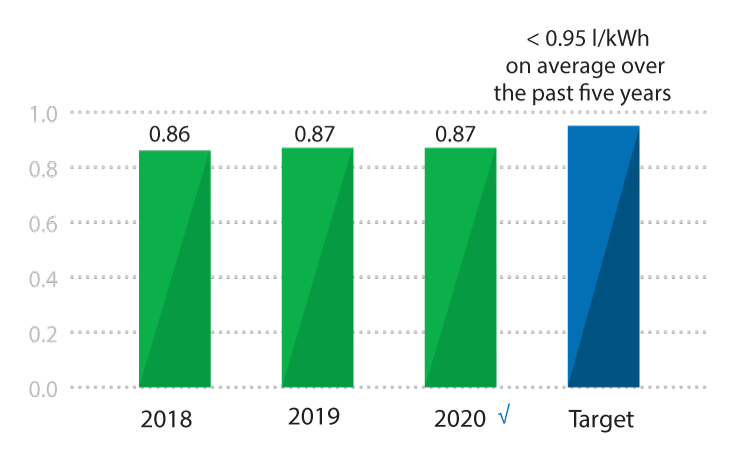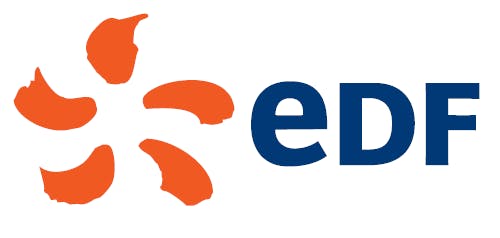EDF has a hydro-meteorological centre that records local data in real time for all its power plants in order to have greater accuracy with respect to time and space in measuring water stress, which is at best a monthly average for these tools. In terms of hydropower generation, the reservoirs are located upstream from basins experiencing water stress, meaning they are regularly required to provide back-up in case of lower water levels. Every 5 years, EDF Hydro reassesses its sites’ generation, taking account of changing hydrology and temperatures due to climate change. Changes in water stress is one of the criteria used to evaluate any new project presented to the investment committee (Executive Committee’s Commitments Committee).
Water withdrawn
69% of the water withdrawn for cooling purposes by the Group comes from marine or estuary environments, where resource availability is not an issue. This percentage is almost 61% in France, over 99% in the United Kingdom and close to 87% in Italy.
The drop in generation due to the Covid effect, combined with numerous unit shutdowns and the closure of Fessenheim, resulted in a significant decrease in the Group’s water withdrawals (-5%) compared to the previous five years, mainly concerning freshwater withdrawals (-13%). The quantity of freshwater sourced from groundwater is marginal and amounts to 2hm3, about 0.01% of the fresh water surface. Mains water is not used for cooling systems but only for various forms of water process for a share lower tha 0.1%.
Returning water to the natural environment
Almost 99% of water withdrawn is returned to the environment.
In accordance with local intake and discharge regulations, the Group’s companies take the necessary measures, as part of their EMS, to comply with water quantity and quality requirements. They have implemented, in tandem with stakeholders, measures tailored to exceptional weather conditions. EDF monitors the indicator parameters for the quality of the terrestrial and aquatic ecosystems (pH, temperature, conductance, O2, etc..) around the sites, including subterranean ground water. The results of this monitoring are provided to the relevant local authorities and used in documents available to the public. There were no significant water-related environmental events or fines in 2020.
Water intensity
The volume of evaporated water(1) in absolute terms (435hm3) fell sharply by 11%. As for withdrawals, this fall was mainly due to the energy mix used (fall in nuclear generation and unit shutdowns). France (96%) and the United Kingdom (2%) accounted for most of this volume. Specific consumption of evaporated water per kilowatt hour of electricity generated, also called water intensity, was stable compared to 2019 (0.87l/kWh).
2016-2020 average water intensity was 0.87l/kWh. The stated aim is to remain below the target of 0.95l/kWh on average over the five past years, by progressively reducing specific water consumption by 2030 (the benchmark being the 2015 level. (0.96l/kWh)). This threshold, which is much lower than the industry average, particularly in the US(2), would serve to put an exceptional climatic year into perspective. Taking account of the expected variation in generation resources and actions taken to optimise water, total Group-wide freshwater withdrawal and consumption should fall in the coming years.
Water intensity: water consumed / electricity generated by fleet (l/kWh)

2018 : 0.86
2019 : 0.87
2020 : 0.87
Target : < 0.95 on average over the past five years
Key non-financial performance indicator
√ 2020 indicator subject to reasonable assurance check by KPMG S.A.
The methodology for this indicator is set out in detail in section 3.7.2.2"Details on performance indicators".
3.2.3.1.2Optimisation of water use and reducing pressure on environments
The optimisation of water used in EDF’s generation activities enables to ensure management of water resources and to honouring the Group’s commitment to guarantee multi-purpose water resources (drinking water, water for irrigation, tourism, etc.) and in view of the needs of local authorities. The EDF group is working on several levers to optimise its water use and reduce pressure on the environment, by reducing its water consumption, reusing and/or recycling it, and using seawater desalination processes.
Water consumption reduction and withdrawal limitation measures
In French overseas departments, R&D teams have designed dry air cooling systems for engine cooling, which reduce water withdrawal. Now, EDF PEI’s power plants are no longer cooled with saltwater, and rainwater recovery tanks were installed on some plants (Guadeloupe) to reduce water withdrawals.
This year, the Golfech nuclear power plant closed a trial with a local EMS to reduce its water withdrawals from the Garonne river, as well as use of chemicals to produce demineralised water (300,000m3 /year). Thanks to the implementation of effluentreuse and seawater desalination systems, the Martigues and Blénod sites are expected to reduce water withdrawal and consumption by 2021. In Chile, following along drought that caused the water table to fall by 1m in less than a year, specific measures were taken for the combined cycle power plant in Nueva Renca, enabling halving of process water, which plummeted from 12t/h to 6t/h. In Brazil, a plan for a second combined cycle power plant after Norte Fluminense is under consideration, featuring an air- rather than water-based cooling system from the design phase.
In order to reduce water consumption leaks from the Group’s buildings, remote monitoring is carried out on 57 sites, and consumption reduction measures have been implemented (foamers on taps, automatic taps, dual-flush toilets, etc.).
(1) Of which 99.5% fresh water.
(2) Intensity ranging between 1.43 and 3.54l/kWh. see “Regional water consumption for hydro and thermal electricity generation in the United States” – Applied Energy journal– May 2017.
